Execution: 1.5 out of 5 (0 out of 5 for the MMF-2 alone)
Yeah, but: An odd-ball hybrid, neither fish nor fowl.
The Long Version: Earlier this year, Olympus released a micro four-thirds hardware mash-up consisting of a regular four-thirds kit zoom lens and an adapter for use on the digital Pen E-PL1 (and ostensibly for the E-P1 and E-P2). For the budding Pen lens line, it was a great idea; take an existing 4:1 kit zoom from its standard four-thirds grade lineup, match it with a four-thirds to micro four-thirds adapter, give it an enticing bargain price, then pitch it towards the market segment that would also be interested in purchasing the E-PL1. And that's what Olympus did with the Zuiko Digital ED 40-150mm F4.0-5.6 and the MMF-2 four-thirds to micro four-thirds adapter.
As I said, as a concept, it's great, especially when you consider the costs of the individual items. The zoom lens' official MSRP is $279, while the adapter's official MSRP is $199. The combined cost, if bought from Olympus, would set you back some $380. Olympus sold the two of them together for a mere $199, essentially giving the zoom away with the purchase of the adapter. What probably sealed the deal for Olympus is the fact that the current 40-150mm kit lens was designed to work effectively on Olympus DSLRs (E-4x0, E-5x0, E-6x0 and E-30) using their variant of contrast detect autofocus (CDAF) while those DSLRs were in live view mode.
As the old saying goes, it if sounds to good to be true, it probably is. In this case the too-good-to-be part was the adapter.
The original Olympus four-thirds to micro four-thirds adapter (on the left, above), the MMF-1, was released along with the first digital Pen, the E-P1. Like the E-P1 and E-P2, it was a small precision part, manufactured to a high quality standard. Light enough to add little weight-wise to an adapter four-thirds lens, but with enough heft to communicate a feeling of quality, from the metal mount on the front to the metal bayonet on the back, you just knew the MMF-1 was something you could depend on. Not so with the MMF-2.
When the E-PL1 was released, Olympus replaced the MMF-1 with the MMF-2, and for the same price of $199. And that's unfortunate; while the MMF-1 had metal in all the right places, the MMF-2 is totally plastic in construction. After using this combination on my E-P2 for the last three months, I've noticed that a small deformation has formed on the bayonet lock hole. This is the hole into which the mount's lock pin inserts when you twist the lens into place. The deformation is on the side that strikes the pin when the lens comes to a stop. There's only one other spot I've seen this, and its on the zoom lens' plastic bayonet.
I'm not against the use of plastic in cameras. Material science has advanced tremendously so that many plastics provide a better, lighter weight, and stronger alternative to metals. The problem is that the type of plastics Olympus chose for this application is inferior to the use of metal. My advice: if you're in the market for just the adapter, then buy Panasonic's DMW-MA1 four-thirds to micro four-thirds adapter. The Panasonic adapter is metal front and back, and can be purchased from most retailers for a little more than $100, or half the price of Olympus' inferior offering.
Moving on to the second item in the combination, we come to the Olympus 40-150mm ED kit zoom lens. This zoom, along with the 14-42/45mm zoom, has been a kit stalwart since the early days, first showing up with the Olympus E-300 (my first four-thirds camera). This version, dubbed unofficially as the Mark 1 version, was solid, a bit large, and gave good performance for what it was; an inexpensive 4:1 telephoto lens for the masses.
But time and technology marched on; when Olympus introduced the E-4x0 and E-5x0 mid-range DSLRs, they revamped both kits to be smaller and lighter, shortening the range of the 14-45mm to 14-42mm, while drastically decreasing the size and weight of the 40-150mm and dropping the max aperture at 40mm from f/3.5 to f/4 in the process. They also added a circular aperture and a single ED glass element. The final result for the 40-150mm was a lens that, when zoomed into 40mm, fit easily into the palm of your hand.
Zoomed out to 150mm it's a different matter; at that focal length the zoom is physically over twice as long as it is at 40mm and a full stop slower at f/5.6. But that's no problem, as the lens is still easy enough to handle, and the front element stays in a fixed position regardless of zoom length or focus distance.
The 40-150mm is meant to be a "cost efficient" lens, or in an earlier time, a budget lens. And for what it costs in the regular market (around $115), it's probably one of the best little budget zooms you can purchase. But make no mistake, it's a budget lens; the only non-plastic components in the lens are a few bits of metal contacts, the focus motor, and the glass. The rest is spare plastic that has been designed down to a bare minimum.
In my collection of Olympus glass I'm fortunate to have the outstanding 50-200mm f/2.8-3.5 High Grade zoom lens. Mounted on my E-3, it represents the standard in my personal collection for image quality and general performance. And in that regard the 50-200mm walks all over the 40-150mm. But as you can see in the illustration above, the 50-200mm, on the left, dwarfs both the 40-150mm (center) and the 14-42mm collapsible micro four-thirds kit zoom (right). On size alone, the 40-150mm is the kind of lens you carry with you on impulse; the 50-200mm is the kind of lens you plan to use in advance. And keep in mind the 50-200m costs roughly five times the cost of the 40-150mm and MMF-2 combination, ten times considering the 40-150mm alone.
How well does it perform in real life? Because the 40-150mm is not a native micro four-thirds lens, its autofocus performance is slower than either the 17mm or 14-42mm kit lens, especially at 40mm. Further out into the range up to and including 150mm, the 40-150mm is almost as fast in focus performance as the micro four-thirds standards.
When it comes to optical performance, the 40-150mm provides good (and some may argue excellent) performance for the cost of the lens. It's no 50-200mm, but for what it costs it's more than Good Enough.
In summary, the two items together fall down a bit, especially if you already have the more upscale E-P2. And that's a shame, really, because the combined size and weight of the two is light enough that it makes a decent companion worth having in the bag.
There are several alternatives to this kit, especially if you're on a tight budget. The first is to look at the Panasonic Lumix G Vario 45-200mm F4-5.6 telephoto zoom lens. The Panasonic is larger and longer than the Olympus combination and the price of the Panasonic is higher, floating between $300 to $350 dollars on the open market. If you want to spend closer to $200, then purchase the Panasonic DMW-MA1 adapter (around $100) along with the Olympus 40-150mm zoom from someone else other than Olympus; Amazon has the Olympus zoom for $130, while B&H Photo has it for $112. The combination of the two separate items, while costing slightly more than the Olympus combination, will give you much better overall quality, especially with regards to the adapter, while preserving the combination's overall compact size.
Update
I should have checked my sources before writing about my dislike of plastic lens mounts. And I should have gone shopping at Walmart. But first things first.
Andrzej Wrotniak has an extensive site devoted to Olympus, including the E series of digital cameras, ranging from the E-1 up to and including the E-P2. In 2007 Wrotniak wrote a review of his own copy of the E-510, in which he noted the fact that the 40-150mm kit zoom, the same version written about above, had been introduced with the E-510 and had a plastic mount. Wrotniak had this to say about plastic mounts:
Nothing, however, comes free. To trim the weight, Olympus engineers had to reduce the use of metal in these lenses, up to using plastic lens mounts. While something makes me to abhor this very idea, I understand the reasons behind it: attaching a metal bayonet to a totally plastic construction would only move the point of mechanical vulnerability from the bayonet itself to the screws securing it to the rest of the lens. Anyway, only time will tell how does the plastic mount affect long-term reliability and precision of these lenses.And sure enough, while shopping for groceries at a near-by Walmart, I cruised by the electronics section (to satisfy the inner geek) before hitting the grocery side. And right there, in the small camera section, were two zoom lenses, one from Nikon (Nikon 55-200mm f/4-5.6G IF-ED AF-S DX VR) and one from Canon (EF-S 55-250mm f/4-5.6 IS), both with plastic mounts.
To be impartial: almost all other manufacturers (except for Pentax) have been using plastic mounts in their "kit" lenses for a few years already; Olympus was, as far as I know, the next-to-last Mohican.
So I guess I should get over my bias towards plastic lens mounts, especially in Olympus, since "everybody is doing it." But I still stand by my assessment of the MMF-2. If you can find the Panasonic adapter for around $100, then buy it over the Olympus.


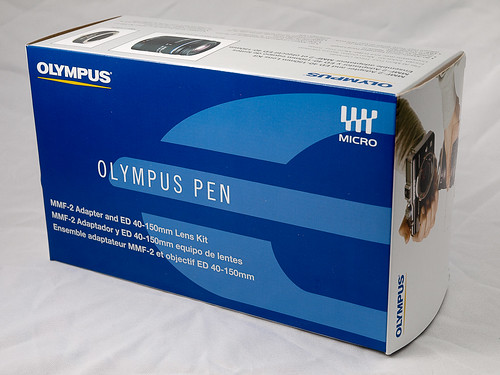

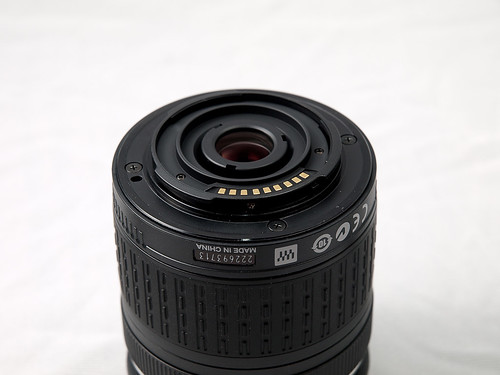
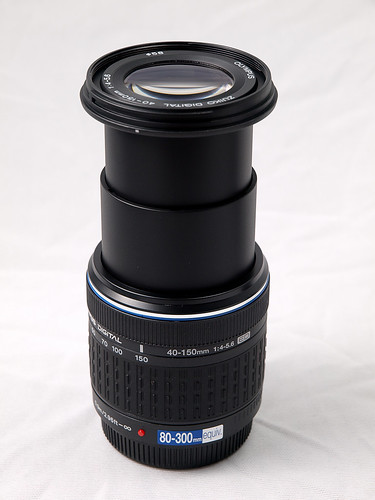
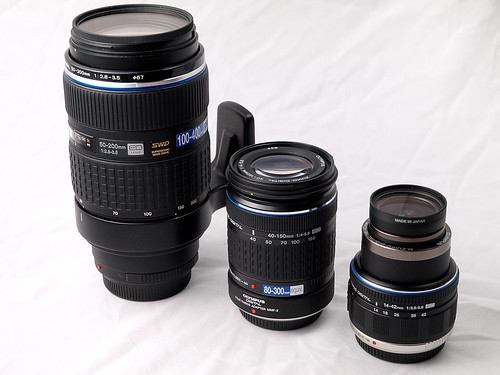

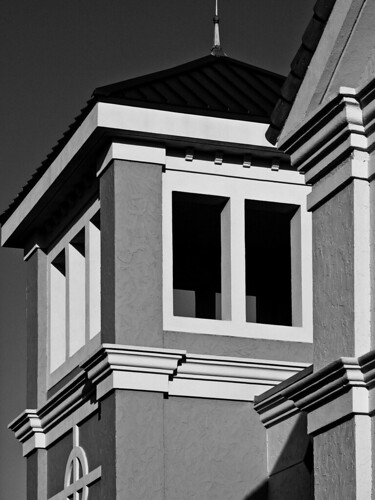







I am a bit mystified as to why Olympus did NOT provide a medium telephoto zoom in the 35-100 to 40-150 size native to the micro 4/3 mount. While I doubt that that a micro 4/3 40-150 would be that much smaller than the regular 40-150, it would still be nice to have a telephoto zoom option that is optimized for the mount you are using, especially in regards to auto-focus.
ReplyDeleteHowever, as a person who has owned the 40-150 f.4-5.6 for three years, I can honestly say that the lens is extremely robust despite it's lightweight plastic construction, and has been one of my most consistent performing lenses in terms of auto-focus and image quality. I have absolutely nothing bad to say about it, as it has proven it's worth ten times over.
One area where that lens really shines is in the realm of portrait photography, it really does a fantastic job taking pictures of people and pets.
As Bill points out, even if you own the very capable Olympus 50-200, the 40-150 is worth having if only because it's a lens you can take with you anywhere at anytime.